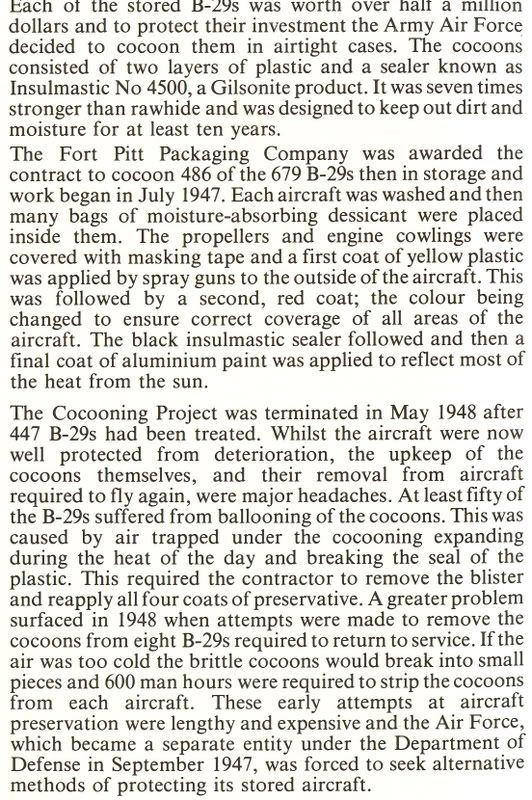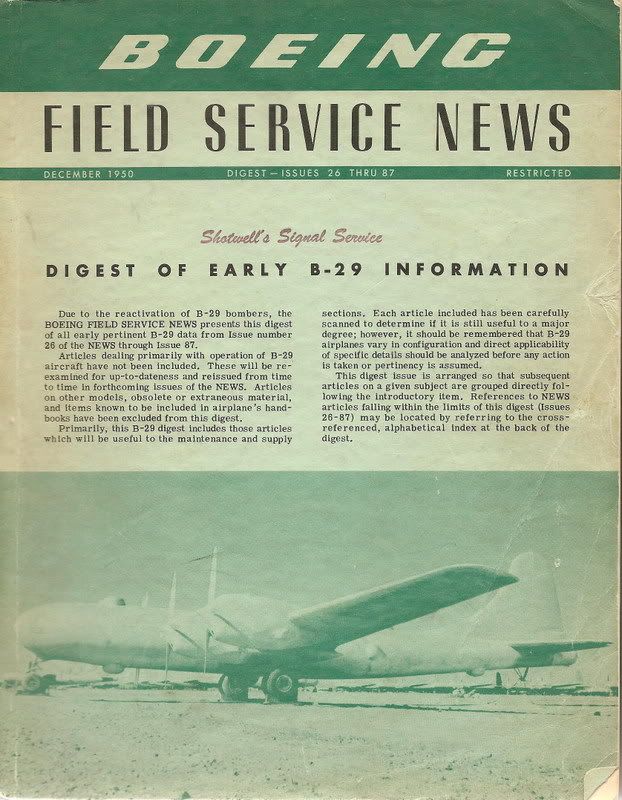Re-Activating B-29's in 1950
Thu Jan 08, 2009 10:59 pm
Activating Planes July 07, 1950 Joe Scherschel






Thu Jan 08, 2009 11:05 pm
Did I read somewhere that ops just like this were conducted at Robins AFB near Macon, GA? If not these pictures ... does anyone have info on B-29s stored at Robins?
B-29s ....at Pyote?
Thu Jan 08, 2009 11:14 pm
Are these photos at Pyote, TX?
Fri Jan 09, 2009 1:10 am
Ken,
The AAF cocooned B-29s at Pyote, Davis Monthan, and some at Robins. I think some were cocooned at the Tinker storage area as well. I have a couple of books with photos from Robins, and I believe the test on the cocooning material was done there.
L.T., I agree--the terrain and plant life in these photos looks a lot more like Pyote than anywhere else. A lot of the low-time Superforts at Pyote got the complete sealing treatment.
Scott
The AAF cocooned B-29s at Pyote, Davis Monthan, and some at Robins. I think some were cocooned at the Tinker storage area as well. I have a couple of books with photos from Robins, and I believe the test on the cocooning material was done there.
L.T., I agree--the terrain and plant life in these photos looks a lot more like Pyote than anywhere else. A lot of the low-time Superforts at Pyote got the complete sealing treatment.
Scott
Fri Jan 09, 2009 4:33 am
could someone explain how the B29's were preserved, it looks like they have been wrapped in canvas(?) and then had something sprayed over the canvas to seal them up?
Cheers
Matt
Cheers
Matt
Fri Jan 09, 2009 6:17 am
That first picture is great!
Fri Jan 09, 2009 7:44 am
It looks to me that they were cocooned with a spray on material. I think it was called Spray Lat and it was developed during the war to protect aircraft shipped as deck cargo. I don't know if it is the same material that is used to cover boats for the winter but it has to be similar.
The basic process was to preserve the engines with preservative oil and then remove weapons. Some openings were specifically plugged with covers and then the spray on material was applied usually to the upper surfaces so that drain and vent holes in the lower surfaces could still circulate air and allow condensation moisture to drain out. I am not sure about fuel tanks. Either they were filled to prevent air from drying out the rubber or they were emptied and then coated on the interior with a preservative oil. My guess there is it depended on how long they expected the aircraft to remain stored since the fuel would degrade in octane rating over time.
The basic process was to preserve the engines with preservative oil and then remove weapons. Some openings were specifically plugged with covers and then the spray on material was applied usually to the upper surfaces so that drain and vent holes in the lower surfaces could still circulate air and allow condensation moisture to drain out. I am not sure about fuel tanks. Either they were filled to prevent air from drying out the rubber or they were emptied and then coated on the interior with a preservative oil. My guess there is it depended on how long they expected the aircraft to remain stored since the fuel would degrade in octane rating over time.
Fri Jan 09, 2009 9:00 am

From Desert Boneyard by Philip Chinnery
Mike
Fri Jan 09, 2009 10:35 am
Here is a cocooned B-29 at Tucson, courtesy of the Boeing Technical Publications Department, circa 1950.


Fri Jan 09, 2009 10:59 am
The problems that they had in stripping the B-29s pushed them to develop the process that ultimately became the Spraylat process that they have been using since the 60s. They also have developed a bagged system for the fighters.
The Spraylat process is nothing like shrink wrapping a boat. I don't think they've tried the shrink wrap method out in Tucson yet.
The Spraylat process is nothing like shrink wrapping a boat. I don't think they've tried the shrink wrap method out in Tucson yet.
Fri Jan 09, 2009 12:19 pm
Rick,
We took the "old" tour of AMARC (when you could still get off the bus and wander around a small area designated by the Sergeant leading the tour) and they had an F-8 and F-4 bagged. The tour guide told me that they were the first two that AMARC had tried the bags on and they weren't working out as they'd hoped, but the contractor had other, better, alternatives on the drawing board. The process on those two was possibly the precursor to the modern shrink wrap method. The interesting thing about the problems they were experiencing with those two bagged airplanes was that the exact same problems occurred with the cocooning of the B-29s. The covering would expand too much on hot days, and when it got really cool the covering didn't contract. This caused sagging, tearing, and other preservation problems, including condensation between the covering and lower side of the airplane.
Scott
We took the "old" tour of AMARC (when you could still get off the bus and wander around a small area designated by the Sergeant leading the tour) and they had an F-8 and F-4 bagged. The tour guide told me that they were the first two that AMARC had tried the bags on and they weren't working out as they'd hoped, but the contractor had other, better, alternatives on the drawing board. The process on those two was possibly the precursor to the modern shrink wrap method. The interesting thing about the problems they were experiencing with those two bagged airplanes was that the exact same problems occurred with the cocooning of the B-29s. The covering would expand too much on hot days, and when it got really cool the covering didn't contract. This caused sagging, tearing, and other preservation problems, including condensation between the covering and lower side of the airplane.
Scott
Fri Jan 09, 2009 2:25 pm
Wow great photos. Looks like it took a lot of preparation to make them flight ready again.
Sat Jan 10, 2009 1:49 am
Can you imagine doing that job on a typical west Texas (or Tucson) July day?  As a matter of fact, Pyote had a really hard time hiring and retaining people to both cocoon the airplanes and remove the material years later.
As a matter of fact, Pyote had a really hard time hiring and retaining people to both cocoon the airplanes and remove the material years later.
 As a matter of fact, Pyote had a really hard time hiring and retaining people to both cocoon the airplanes and remove the material years later.
As a matter of fact, Pyote had a really hard time hiring and retaining people to both cocoon the airplanes and remove the material years later.
Sun Jan 11, 2009 10:05 pm
One photo has a guy washing some brakes that aren't from a B-29. Any ideas?
Sun Jan 11, 2009 10:15 pm
I wondered about that too--could the brakes be A-26 units? Pyote reactivated a large number and parted out a good many A-26s to support the Korean conflict.
Scott
Scott